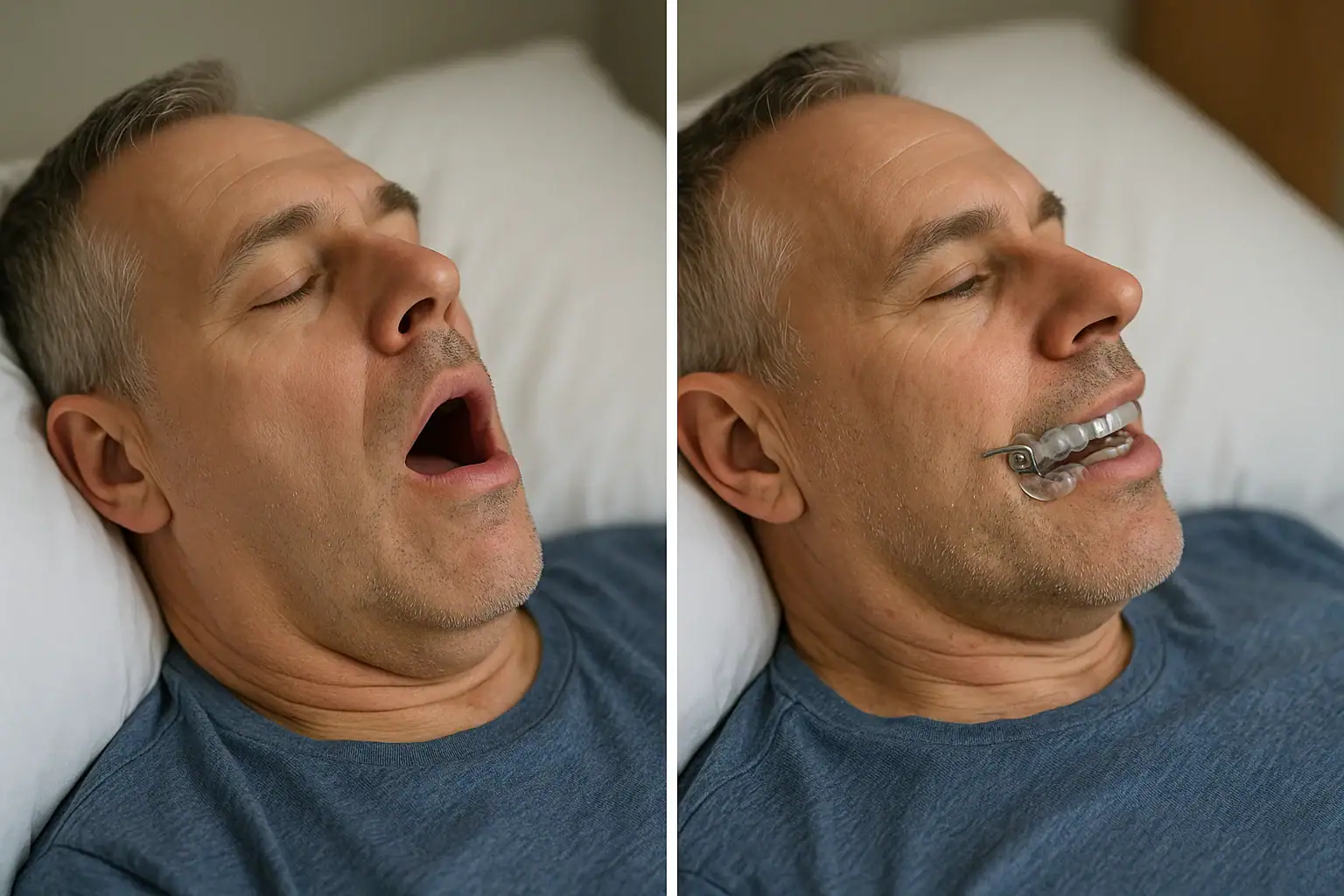Menu
Free Consultation

Constructive sleep apnea (OSA) is a common but often underdiagnosed sleep disorder that affects millions worldwide. It occurs when the upper airway collapses repeatedly during your sleep, causing disruption in breathing and lowering oxygen levels.
Traditionally, Continuous Positive Airway Pressure (CPAP) therapy has long been the gold standard for this disorder. However, many patients struggle with comfort and compliance during their treatment.
This is where dentists trained in oral appliance therapy for sleep apnea play a crucial role. These specialists use custom-made mandibular advancement devices (MADs) to offer an effective, non-invasive solution that improves sleep quality and reduces the health risk associated with sleep-disordered breathing.
OSA is a condition characterized by repeated episodes of partial or complete upper airway obstruction during sleep, despite ongoing respiratory effort. In other words, respiration gets interrupted multiple times during sleep, despite trying to take air. These interruptions, known as sleep apneas (complete blockage) and hypopneas (partial blockage), cause fragmented sleep and oxygen desaturation.
According to the American Academy of Sleep Medicine (AASM), OSA affects roughly 15–30% percent of males and 10–15% percent of females, with many cases remaining undiagnosed. Some risk factors include:
Untreated OSA contributes to several systemic health problems, including:
As a result, early diagnosis and effective management are essential for patients to prevent severe complications and systemic issues.
Oral Appliance therapy (OAT) involves using a custom-fitted device worn in the mouth during sleep. This appliance, typically a mandibular advancement device (MAD), works by gently positioning the lower jaw and tongue forward. This forward movement enlarges the upper airway and reduces the likelihood of breathing collapse.
These appliances are individually designed by trained dentists who ensure both comfort and efficacy in dental sleep medicine.
Studies have shown that oral appliances significantly reduce the Apnea-Hypopnea Index (AHI) in patients with mild to moderate OSA, often improving oxygen saturation and reducing snoring intensity.
A recent study published in the Journal of Clinical Sleep Medicine (2015), assessed the effectiveness of MAD vs. CPAP treatment, finding that oral appliance therapy was equally effective as CPAP in reducing symptoms and improving quality of life in mild to moderate OSA, probably due to better patient adherence with oral appliances over time. However, CPAP showed greater physiological improvement, and it’s still considered the gold standard treatment for OSA in most systematic reviews.
As a result, oral appliance therapy offers a viable, scientifically supported alternative for patients who cannot tolerate CPAP.
While OSA is a medical condition, dentists specialized in this therapy display a collaborative role in its management, particularly in fitting and monitoring oral appliances. However, not every dentist is trained to provide sleep-disorder care.
Specialists qualified to treat OSA typically undergo specialized education in dental sleep medicine, recognized by some organizations such as:
Despite their qualifications, the dentist’s role only begins after diagnosis and is mainly focused on fabrication, adjustments and follow-up care of these oral appliances.
To start your treatment, ensure your dentist is properly trained by asking:
Selecting your practitioner is crucial to obtaining a sleep dentistry solution. Consider the following:
Experience and Accreditation
Look mainly for dentists accredited by professional organizations such as the AADSM or the American Board of Dental Sleep Medicine.
Collaborative Approach
The best professionals work in partnership with other specialists, particularly sleep specialists, primary care physicians and sometimes otolaryngologists. This ensures that OSA is properly diagnosed and oral appliance therapy is monitored through the appropriate follow-up.
Customization and Technology
Receiving an effective oral appliance depends on precision. As a result, your dentist should use digital scanning, advanced materials and adjustable designs that allow for incremental improvements of jaw position to achieve the perfect airway patency and comfort.
Long-Term Follow-Up
As a chronic condition, OSA requires ongoing management. Therefore, choosing a dentist who provides regular follow-up visits to assess appliance wear, monitor symptoms and coordinate with other specialists is critical.
Besides improving sleep and reducing apnea events, oral appliance therapy offers traditional advantages, such as:
